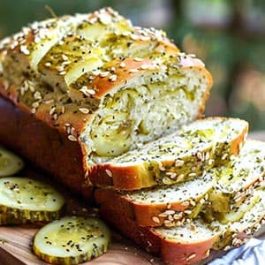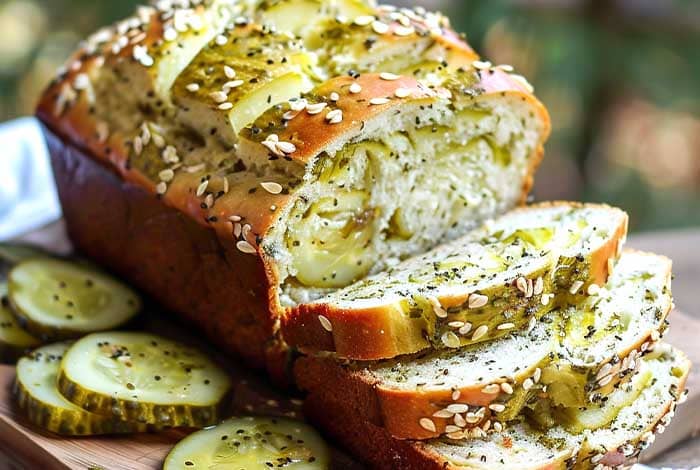Dill Pickle Bread is a unique culinary creation that combines the tangy, savory flavors of dill pickles with the comforting texture of freshly baked bread. This article delves into everything you need to know about making your own Dill Pickle Bread, from the ingredients and step-by-step instructions to serving suggestions and storage tips. Whether you’re a pickle enthusiast or simply looking for a new bread recipe to try, this guide has got you covered.
Introduction to Dill Pickle Bread
Dill Pickle Bread is not your ordinary loaf. This savory bread stands out for its distinctive flavor, brought by the inclusion of chopped dill pickles, dill pickle juice, and fresh dill. The concept might sound unusual at first, but the result is a perfectly balanced, moist, and flavorful bread that’s delicious on its own or as a complement to a variety of dishes.
The origins of incorporating pickles into bread are not well-documented, but it’s a testament to the culinary creativity of bakers looking to infuse unique flavors into their creations. Dill Pickle Bread is a testament to this innovation, offering a taste that’s both familiar and refreshingly new.
The Recipe
Ingredients
- 3/4 cup sour cream for richness and moisture
- 1/2 cup vegetable oil to ensure a tender crumb
- 2 large eggs for structure
- 2 tablespoons dill pickle juice for that tangy pickle flavor
- 1/3 cup finely diced dill pickles for texture and taste
- 1 & 3/4 cups all-purpose flour, spooned and leveled
- 1 packet onion soup mix for added flavor without the need for extra salt
- 2 tablespoons granulated sugar to balance the acidity
- 1 & 1/2 teaspoons baking powder and 1/4 teaspoon baking soda for lift
- 1/4 cup chopped fresh dill for that fresh, herby kick
Step-by-Step Instructions
- Preheat your oven to 350 degrees F (175 degrees C) and line a 9×5 inch loaf pan with parchment paper.
- In a large bowl, whisk together the sour cream, vegetable oil, eggs, and dill pickle juice. Fold in the diced dill pickles.
- Stir in the flour, onion soup mix, sugar, baking powder, baking soda, and fresh dill until just combined. Avoid overmixing to ensure a tender loaf.
- Pour the batter into the prepared pan and smooth the top.
- Bake for 40-45 minutes, or until a toothpick inserted into the center comes out clean.
- Allow the bread to cool in the pan for 10 minutes before transferring it to a wire rack to cool completely.
Variations and Customizations
Dill Pickle Bread offers a canvas for creativity, allowing bakers to experiment with various additions and substitutions to cater to different dietary needs or flavor preferences. Here are some suggestions for customizing your loaf:
- Cheese Addition: Incorporate shredded cheddar or Swiss cheese into the batter for a cheesy, savory twist. The meltiness of the cheese pairs beautifully with the tangy pickle bits.
- Herb Infusions: Beyond dill, consider adding other herbs such as thyme, rosemary, or chives to complement the pickle flavor and add complexity to the bread’s aroma.
- Seed Toppings: For a crunchy texture, sprinkle sesame seeds, poppy seeds, or caraway seeds on top of the loaf before baking.
For those with dietary restrictions, making Dill Pickle Bread gluten-free or vegan is straightforward:
- Gluten-Free Version: Substitute the all-purpose flour with your preferred gluten-free flour blend. Look for blends that are designed for 1:1 substitution to ensure the bread maintains its structure and texture.
- Vegan Version: Replace the eggs with flax eggs (1 tablespoon ground flaxseed mixed with 3 tablespoons water per egg, left to thicken for 5 minutes) and use a dairy-free sour cream alternative. Ensure your dill pickles and any other add-ins are also vegan.
These variations and customizations allow everyone to enjoy Dill Pickle Bread, regardless of dietary preferences or restrictions. Experimenting with different ingredients not only makes the recipe more inclusive but also opens up a world of flavors and textures, making each loaf uniquely delightful.
Serving and Pairing Ideas
Dill Pickle Bread, with its unique blend of tangy, savory flavors, offers a versatile option for various meal settings. Whether you’re looking to enhance a simple breakfast, add a twist to your lunch, or complement a hearty dinner, this bread brings a delightful surprise to the table. Here are some serving and pairing ideas to elevate your culinary experience with Dill Pickle Bread.
How to Serve Dill Pickle Bread
- As a Standalone Snack: Enjoy slices of Dill Pickle Bread toasted with a spread of cream cheese or butter. The warmth of the toast will enhance the bread’s flavors, making it a perfect snack.
- With Soups and Stews: The savory notes of the bread make it an excellent companion to creamy or broth-based soups and hearty stews. Serve it on the side or use it to soak up the delicious flavors of your meal.
- Sandwich Base: Use thick slices of Dill Pickle Bread as the foundation for sandwiches. Its unique flavor pairs well with deli meats, cheese, and additional pickles for a double dose of tanginess.
Pairing Suggestions with Meals and Beverages
- Breakfast Pairings: For a savory start to the day, pair Dill Pickle Bread with scrambled eggs and avocado. The bread’s tanginess complements the creaminess of the eggs and avocado beautifully.
- Lunch Pairings: Create an unforgettable lunch by serving a Dill Pickle Bread sandwich filled with turkey, Swiss cheese, and a smear of Dijon mustard. Pair it with a side salad dressed in a light vinaigrette to balance the meal.
- Dinner Pairings: For dinner, serve slices of Dill Pickle Bread alongside grilled salmon or roasted chicken. The bread’s flavors meld well with the smokiness of the grill and the richness of the meat.
- Beverage Pairings: When it comes to beverages, Dill Pickle Bread pairs nicely with light, crisp beers such as pilsners or lagers. For a non-alcoholic option, try a sparkling lemonade or cucumber water to complement the bread’s tanginess.
Incorporating Dill Pickle Bread into your meals not only adds an element of surprise but also enhances the overall dining experience with its unique flavor profile. Whether you’re enjoying it as part of a meal or as a snack, this bread is sure to spark conversation and delight the taste buds. Experiment with these serving and pairing ideas to discover your favorite way to enjoy Dill Pickle Bread.
Storage and Freshness Tips
To keep your Dill Pickle Bread fresh:
- Wrap it tightly in foil or plastic wrap.
- Store at room temperature for up to 2 days, in the refrigerator for up to a week, or freeze for up to 2 months.
- Thaw frozen bread in the fridge overnight and warm it up in the oven or toaster before serving.
Explore the history of pickles to appreciate the cultural significance of this key ingredient in your new favorite bread.
FAQs
Can I use homemade pickles for this recipe?
- Absolutely! Homemade pickles can be a fantastic addition to this recipe, often bringing a more nuanced flavor than store-bought varieties. Just ensure they’re finely chopped and well-drained before adding them to the batter to maintain the correct moisture balance in the bread.
What can I do if the bread comes out too dry or too moist?
- If your Dill Pickle Bread turns out too dry, consider adding a bit more pickle juice or a tablespoon of sour cream to the batter next time to increase moisture. For bread that’s too moist, reduce the liquid ingredients slightly or add a bit more flour. Remember, the moisture content of your bread can also be affected by factors like the type of flour used, the size of the eggs, and even the humidity in your kitchen.
Are there any low-carb alternatives to the flour used in this recipe?
- Yes, for those following a low-carb diet, almond flour or coconut flour can be good substitutes for all-purpose flour. Keep in mind that these flours have different absorption rates than wheat flour, so you may need to adjust the quantity. Almond flour, for example, might require additional binding agents like extra eggs. Start with a 1:1 substitution ratio and adjust as needed for the desired consistency.
Health Benefits and Nutritional Information
Incorporating dill pickles and fresh dill into your bread not only adds flavor but also brings a host of health benefits, including improved digestion and a boost in vitamins and minerals. For a detailed nutritional breakdown, consider calculating based on the specific brands and quantities of ingredients you use.
For more baking tips and tricks, check out King Arthur Baking’s guide to master the art of bread baking.
Dill Pickle Bread is a delightful twist on traditional bread recipes, offering a unique flavor profile that’s sure to impress. Whether you’re a seasoned baker or new to the kitchen, this recipe is straightforward and rewarding. Give it a try and discover the perfect balance of savory, tangy, and herbaceous flavors in every slice.

Dill Pickle Bread Recipe
Equipment
- 9x5 inch loaf pan
- Mixing bowls
- Whisk
- Measuring cups and spoons
- Parchment paper
Ingredients
- 3/4 cup sour cream
- 1/2 cup vegetable oil
- 2 large eggs
- 2 tablespoons dill pickle juice
- 1/3 cup finely diced dill pickles
- 1 & 3/4 cups all-purpose flour
- 1 packet onion soup mix
- 2 tablespoons granulated sugar
- 1 & 1/2 teaspoons baking powder
- 1/4 teaspoon baking soda
- 1/4 cup chopped fresh dill
Instructions
- Preheat your oven to 350°F (175°C). Line a 9x5 inch loaf pan with parchment paper.
- In a large bowl, whisk together sour cream, vegetable oil, eggs, and dill pickle juice until well combined.
- Fold in the diced dill pickles.
- In another bowl, mix the flour, onion soup mix, sugar, baking powder, and baking soda.
- Gradually add the dry ingredients to the wet ingredients, stirring until just combined. Fold in the chopped fresh dill.
- Pour the batter into the prepared loaf pan and smooth the top with a spatula.
- Bake for 40 minutes, or until a toothpick inserted into the center comes out clean.
- Let the bread cool in the pan for 10 minutes, then transfer to a wire rack to cool completely before slicing.
Notes
- For a gluten-free version, substitute the all-purpose flour with a gluten-free flour blend. Adjust the liquid ingredients if necessary.
- Vegan alternatives: Use a dairy-free sour cream substitute and replace eggs with flax eggs (1 tablespoon ground flaxseed mixed with 3 tablespoons water per egg, let sit for 5 minutes).
- Store leftovers in an airtight container at room temperature for up to 2 days, in the refrigerator for up to 7 days, or freeze for up to 2 months.


I wasn’t sure what to expect, but this Dill Pickle Bread blew me away! Tangy, soft, and packed with flavor. Perfect with cream cheese or sliced ham!
This recipe was such a fun change from my usual bakes! Moist, flavorful, and perfect with deli meats. Definitely a keeper.
Now this is some good bread! I served it alongside grilled pork chops and the flavors worked real nice together. That dill flavor really shines without being overpowering. Great job on this recipe!
This Dill Pickle Bread was downright delightful! I baked it in a cast iron loaf pan and it came out golden and soft with just the right tang. Served it with sliced turkey and sharp cheddar — perfection!